GDNF-deprived sympathetic neurons die via a novel nonmitochondrial pathway
- PMID: 14657232
- PMCID: PMC2173604
- DOI: 10.1083/jcb.200305083
GDNF-deprived sympathetic neurons die via a novel nonmitochondrial pathway
Abstract
The mitochondrial death pathway is triggered in cultured sympathetic neurons by deprivation of nerve growth factor (NGF), but the death mechanisms activated by deprivation of other neurotrophic factors are poorly studied. We compared sympathetic neurons deprived of NGF to those deprived of glial cell line-derived neurotrophic factor (GDNF). In contrast to NGF-deprived neurons, GDNF-deprived neurons did not die via the mitochondrial pathway. Indeed, cytochrome c was not released to the cytosol; Bax and caspase-9 and -3 were not involved; overexpressed Bcl-xL did not block the death; and the mitochondrial ultrastructure was not changed. Similarly to NGF-deprived neurons, the death induced by GDNF removal is associated with increased autophagy and requires multiple lineage kinases, c-Jun and caspase-2 and -7. Serine 73 of c-Jun was phosphorylated in both NGF- and GDNF-deprived neurons, whereas serine 63 was phosphorylated only in NGF-deprived neurons. In many NGF-deprived neurons, the ultrastructure of the mitochondria was changed. Thus, a novel nonmitochondrial caspase-dependent death pathway is activated in GDNF-deprived sympathetic neurons.
Figures

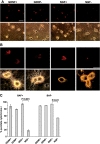
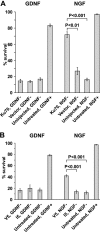

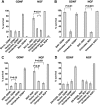

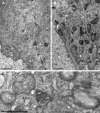
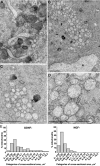

Similar articles
-
Placement of the BCL2 family member BAX in the death pathway of sympathetic neurons activated by trophic factor deprivation.Exp Neurol. 1998 Jul;152(1):150-62. doi: 10.1006/exnr.1998.6846. Exp Neurol. 1998. PMID: 9682022
-
Bcl-xS and Bax induce different apoptotic pathways in PC12 cells.Oncogene. 2000 Mar 30;19(14):1783-93. doi: 10.1038/sj.onc.1203495. Oncogene. 2000. PMID: 10777212
-
Smac induces cytochrome c release and apoptosis independently from Bax/Bcl-x(L) in a strictly caspase-3-dependent manner in human carcinoma cells.Oncogene. 2004 Jun 3;23(26):4523-35. doi: 10.1038/sj.onc.1207594. Oncogene. 2004. PMID: 15064710
-
Death receptors leave a caspase footprint that Smacs of XIAP.Cell Death Differ. 2003 Jan;10(1):4-6. doi: 10.1038/sj.cdd.4401176. Cell Death Differ. 2003. PMID: 12655287 Review. No abstract available.
-
Mouse models of cell death.Nat Genet. 2001 Jun;28(2):113-8. doi: 10.1038/88815. Nat Genet. 2001. PMID: 11381252 Review.
Cited by
-
Mesencephalic astrocyte-derived neurotrophic factor (MANF) has a unique mechanism to rescue apoptotic neurons.J Biol Chem. 2011 Jan 28;286(4):2675-80. doi: 10.1074/jbc.M110.146738. Epub 2010 Nov 3. J Biol Chem. 2011. PMID: 21047780 Free PMC article.
-
CDNF Interacts with ER Chaperones and Requires UPR Sensors to Promote Neuronal Survival.Int J Mol Sci. 2022 Aug 22;23(16):9489. doi: 10.3390/ijms23169489. Int J Mol Sci. 2022. PMID: 36012764 Free PMC article.
-
Neurotrophin-4 regulates the survival of gustatory neurons earlier in development using a different mechanism than brain-derived neurotrophic factor.Dev Biol. 2012 May 1;365(1):50-60. doi: 10.1016/j.ydbio.2012.02.008. Epub 2012 Feb 12. Dev Biol. 2012. PMID: 22353733 Free PMC article.
-
Neurotrophic Factors NGF, GDNF and NTN Selectively Modulate HSV1 and HSV2 Lytic Infection and Reactivation in Primary Adult Sensory and Autonomic Neurons.Pathogens. 2017 Feb 7;6(1):5. doi: 10.3390/pathogens6010005. Pathogens. 2017. PMID: 28178213 Free PMC article.
-
mRNA for N-Bak, a neuron-specific BH3-only splice isoform of Bak, escapes nonsense-mediated decay and is translationally repressed in the neurons.Cell Death Dis. 2012 Feb 2;3(2):e269. doi: 10.1038/cddis.2012.4. Cell Death Dis. 2012. PMID: 22297299 Free PMC article.
References
-
- Airaksinen, M.S., and M. Saarma. 2002. The GDNF family: signalling, biological functions and therapeutic value. Nat. Rev. Neurosci. 3:383–394. - PubMed
-
- Besirli, C.G., and E.M. Johnson, Jr. 2003. JNK-independent activation of c-Jun during neuronal apoptosis Induced by multiple DNA-damaging agents. J. Biol. Chem. 278:22357–22366. - PubMed
-
- Clarke, P.G. 1990. Developmental cell death: morphological diversity and multiple mechanisms. Anat. Embryol. (Berl.). 181:195–213. - PubMed
-
- Deckwerth, T.L., J.L. Elliott, C.M. Knudson, E.M. Johnson, Jr., W.D. Snider, and S.J. Korsmeyer. 1996. BAX is required for neuronal death after trophic factor deprivation and during development. Neuron. 17:401–411. - PubMed
Publication types
MeSH terms
Substances
LinkOut - more resources
Full Text Sources
Other Literature Sources
Molecular Biology Databases
Research Materials
Miscellaneous

